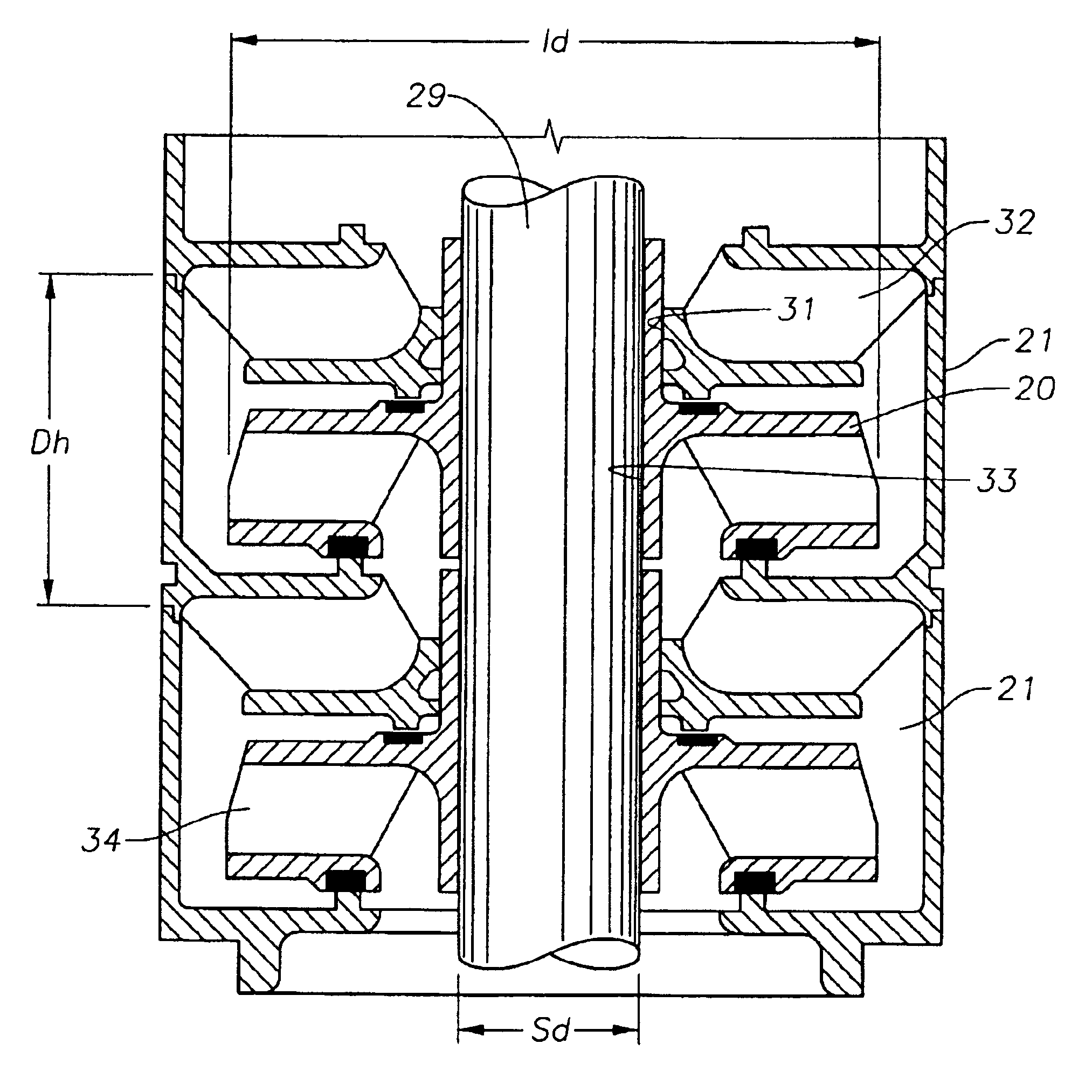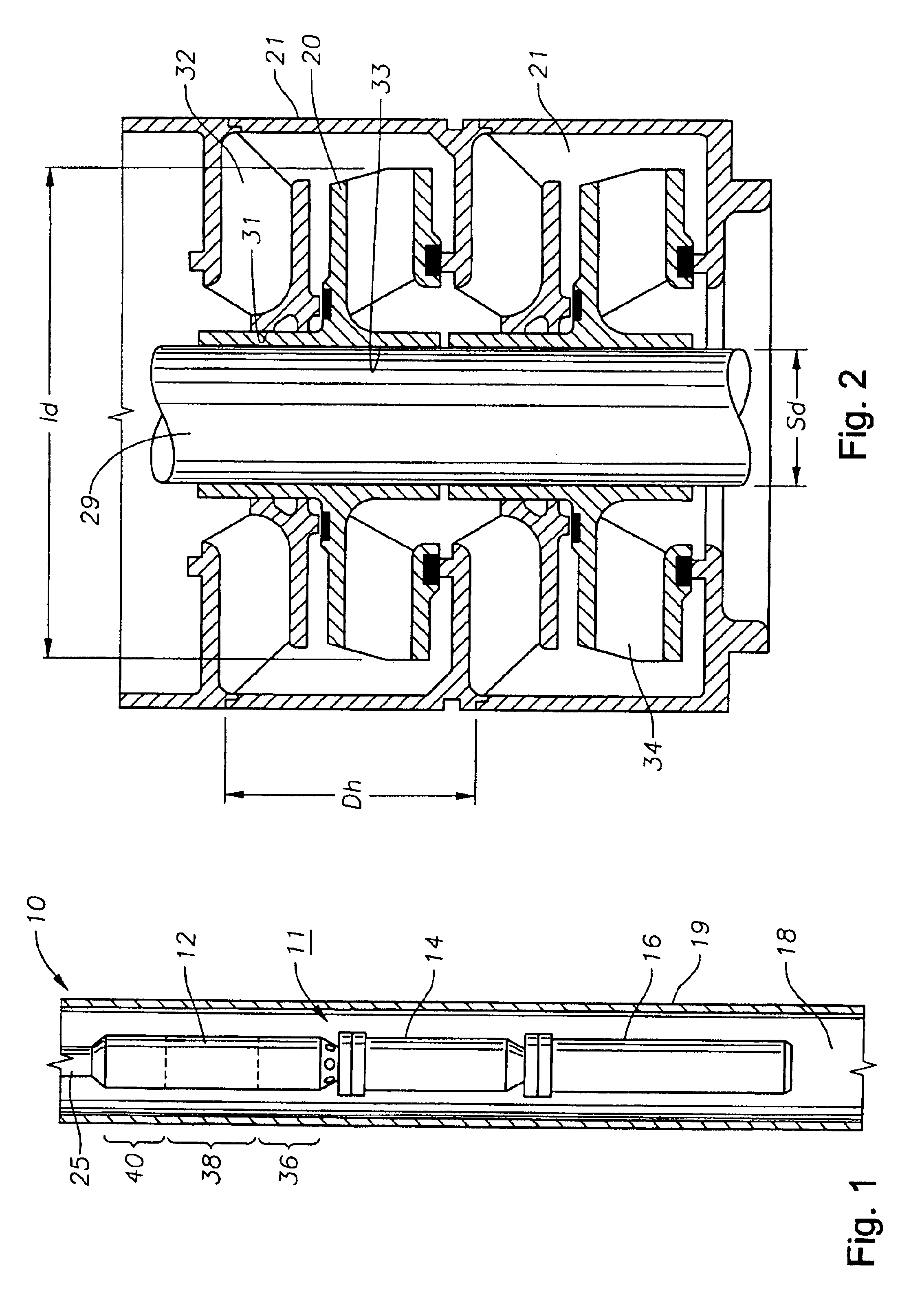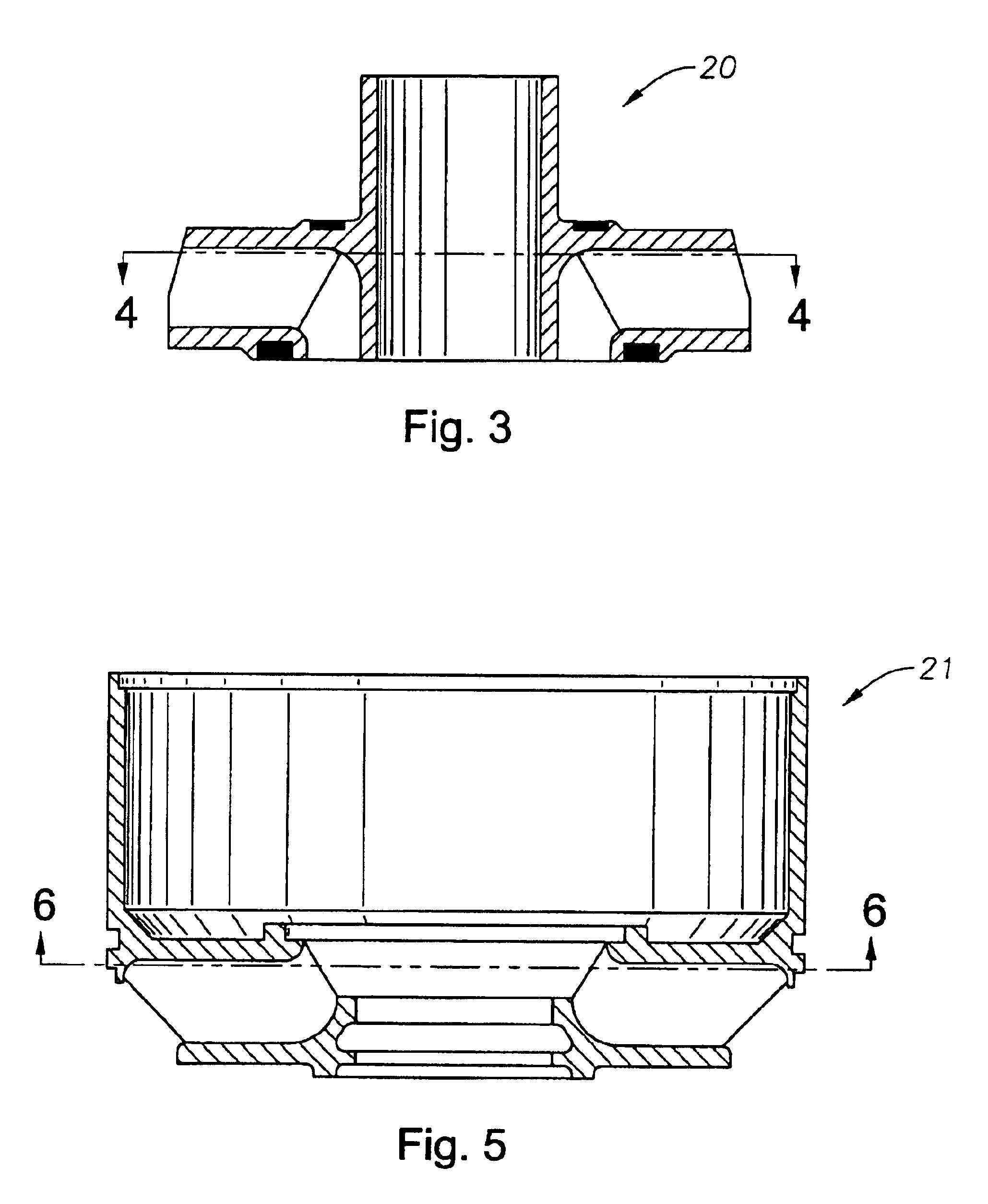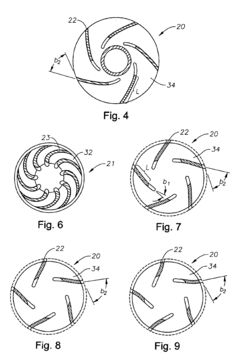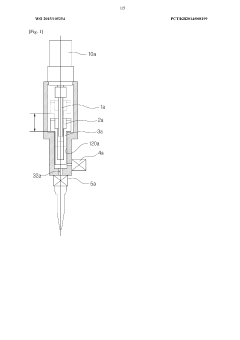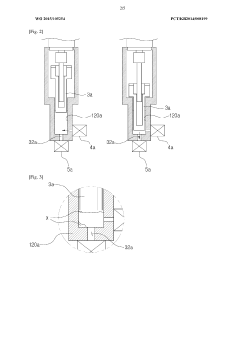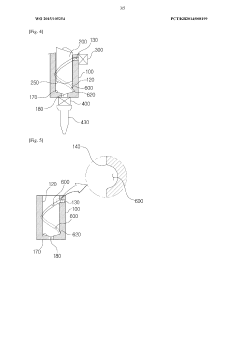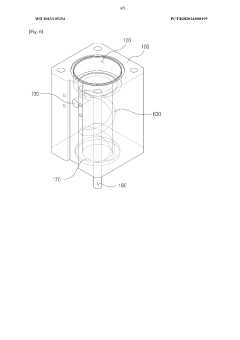Submersible pump design for high-viscosity fluids.
JUL 15, 20259 MIN READ
Generate Your Research Report Instantly with AI Agent
Patsnap Eureka helps you evaluate technical feasibility & market potential.
High-Viscosity Fluid Pump Background and Objectives
Submersible pumps for high-viscosity fluids have become increasingly important in various industries, including oil and gas, chemical processing, and wastewater treatment. The evolution of these pumps can be traced back to the early 20th century when the need for efficient fluid handling in challenging environments became apparent. Over the years, technological advancements have led to significant improvements in pump design, materials, and performance.
The primary objective of high-viscosity fluid pump development is to overcome the challenges associated with moving thick, sticky substances. These fluids often exhibit non-Newtonian behavior, making them particularly difficult to pump efficiently. As industries continue to expand and diversify, the demand for pumps capable of handling a wide range of viscosities has grown substantially.
One of the key trends in submersible pump technology for high-viscosity fluids is the focus on energy efficiency. With increasing emphasis on sustainability and cost reduction, manufacturers are striving to develop pumps that can maintain high performance while consuming less power. This has led to innovations in impeller design, motor efficiency, and overall pump geometry.
Another significant trend is the integration of smart technologies and IoT capabilities into pump systems. These advancements allow for real-time monitoring, predictive maintenance, and remote operation, which are particularly valuable when dealing with challenging fluids in hard-to-reach locations.
Material science has played a crucial role in the evolution of high-viscosity fluid pumps. The development of corrosion-resistant alloys and advanced polymers has enabled pumps to withstand harsh chemical environments and abrasive fluids, significantly extending their operational lifespan and reliability.
The miniaturization of pump components while maintaining or improving performance is another notable trend. This has led to the creation of more compact and versatile pump designs that can be deployed in space-constrained applications without sacrificing efficiency or capacity.
As we look to the future, the goals for high-viscosity fluid pump technology include further improvements in energy efficiency, the ability to handle even higher viscosities, and enhanced resistance to wear and corrosion. Additionally, there is a growing focus on developing pumps that can adapt to varying fluid properties in real-time, ensuring optimal performance across a wide range of operating conditions.
The primary objective of high-viscosity fluid pump development is to overcome the challenges associated with moving thick, sticky substances. These fluids often exhibit non-Newtonian behavior, making them particularly difficult to pump efficiently. As industries continue to expand and diversify, the demand for pumps capable of handling a wide range of viscosities has grown substantially.
One of the key trends in submersible pump technology for high-viscosity fluids is the focus on energy efficiency. With increasing emphasis on sustainability and cost reduction, manufacturers are striving to develop pumps that can maintain high performance while consuming less power. This has led to innovations in impeller design, motor efficiency, and overall pump geometry.
Another significant trend is the integration of smart technologies and IoT capabilities into pump systems. These advancements allow for real-time monitoring, predictive maintenance, and remote operation, which are particularly valuable when dealing with challenging fluids in hard-to-reach locations.
Material science has played a crucial role in the evolution of high-viscosity fluid pumps. The development of corrosion-resistant alloys and advanced polymers has enabled pumps to withstand harsh chemical environments and abrasive fluids, significantly extending their operational lifespan and reliability.
The miniaturization of pump components while maintaining or improving performance is another notable trend. This has led to the creation of more compact and versatile pump designs that can be deployed in space-constrained applications without sacrificing efficiency or capacity.
As we look to the future, the goals for high-viscosity fluid pump technology include further improvements in energy efficiency, the ability to handle even higher viscosities, and enhanced resistance to wear and corrosion. Additionally, there is a growing focus on developing pumps that can adapt to varying fluid properties in real-time, ensuring optimal performance across a wide range of operating conditions.
Market Analysis for High-Viscosity Fluid Pumps
The market for high-viscosity fluid pumps has been experiencing significant growth in recent years, driven by increasing demand across various industries such as oil and gas, chemical processing, and wastewater treatment. The global market for these specialized pumps is expected to continue its upward trajectory, with a compound annual growth rate (CAGR) projected to be robust over the next five years.
In the oil and gas sector, the need for efficient extraction of heavy crude oil has been a major factor contributing to the demand for high-viscosity fluid pumps. As easily accessible oil reserves become depleted, companies are increasingly turning to more challenging reservoirs that contain heavier, more viscous crude. This trend has led to a surge in demand for submersible pumps capable of handling these high-viscosity fluids.
The chemical processing industry has also been a key driver of market growth. As manufacturers seek to improve efficiency and reduce costs, there is a growing need for pumps that can handle a wide range of viscous chemicals and slurries. This has led to increased investment in research and development to create more versatile and durable pump designs.
Wastewater treatment plants represent another significant market segment for high-viscosity fluid pumps. As environmental regulations become more stringent and urbanization continues to increase, there is a growing need for pumps that can effectively handle thick sludges and other high-viscosity waste materials.
Geographically, North America and Europe have traditionally been the largest markets for high-viscosity fluid pumps, primarily due to their well-established oil and gas industries and advanced manufacturing sectors. However, the Asia-Pacific region is emerging as a rapidly growing market, driven by increasing industrialization and infrastructure development in countries such as China and India.
The market is characterized by intense competition among a few key players, with companies focusing on technological innovation and product differentiation to gain a competitive edge. There is a growing trend towards the development of smart pumps with advanced monitoring and control capabilities, as well as pumps that offer improved energy efficiency and reduced maintenance requirements.
Despite the positive growth outlook, the market faces certain challenges. The high initial cost of specialized high-viscosity fluid pumps can be a barrier to adoption, particularly for smaller companies or in developing markets. Additionally, the cyclical nature of the oil and gas industry can lead to fluctuations in demand, impacting overall market stability.
In the oil and gas sector, the need for efficient extraction of heavy crude oil has been a major factor contributing to the demand for high-viscosity fluid pumps. As easily accessible oil reserves become depleted, companies are increasingly turning to more challenging reservoirs that contain heavier, more viscous crude. This trend has led to a surge in demand for submersible pumps capable of handling these high-viscosity fluids.
The chemical processing industry has also been a key driver of market growth. As manufacturers seek to improve efficiency and reduce costs, there is a growing need for pumps that can handle a wide range of viscous chemicals and slurries. This has led to increased investment in research and development to create more versatile and durable pump designs.
Wastewater treatment plants represent another significant market segment for high-viscosity fluid pumps. As environmental regulations become more stringent and urbanization continues to increase, there is a growing need for pumps that can effectively handle thick sludges and other high-viscosity waste materials.
Geographically, North America and Europe have traditionally been the largest markets for high-viscosity fluid pumps, primarily due to their well-established oil and gas industries and advanced manufacturing sectors. However, the Asia-Pacific region is emerging as a rapidly growing market, driven by increasing industrialization and infrastructure development in countries such as China and India.
The market is characterized by intense competition among a few key players, with companies focusing on technological innovation and product differentiation to gain a competitive edge. There is a growing trend towards the development of smart pumps with advanced monitoring and control capabilities, as well as pumps that offer improved energy efficiency and reduced maintenance requirements.
Despite the positive growth outlook, the market faces certain challenges. The high initial cost of specialized high-viscosity fluid pumps can be a barrier to adoption, particularly for smaller companies or in developing markets. Additionally, the cyclical nature of the oil and gas industry can lead to fluctuations in demand, impacting overall market stability.
Technical Challenges in Submersible Pump Design
Submersible pump design for high-viscosity fluids presents several significant technical challenges that require innovative solutions. One of the primary obstacles is the increased power consumption necessary to overcome the viscous forces of the fluid. As the viscosity increases, the pump requires more energy to maintain the desired flow rate, leading to reduced efficiency and potentially shorter operational lifespans.
The design of impellers and diffusers for high-viscosity applications is particularly complex. Traditional impeller designs often fail to provide adequate performance when dealing with viscous fluids, as they struggle to create the necessary flow patterns and pressure differentials. Engineers must develop specialized impeller geometries that can effectively handle the increased fluid resistance while maintaining optimal hydraulic efficiency.
Heat generation and dissipation pose another critical challenge in submersible pump design for high-viscosity fluids. The increased friction between the fluid and pump components results in higher operating temperatures, which can lead to premature wear, seal failures, and potential fluid degradation. Implementing effective cooling mechanisms without compromising the pump's submersible nature requires innovative thermal management solutions.
Material selection becomes crucial when designing pumps for viscous fluids. The pump components must withstand not only the corrosive or abrasive properties of the fluid but also the increased mechanical stresses caused by the higher viscosity. This necessitates the use of advanced materials with superior wear resistance and strength, often at a higher cost.
Sealing systems in submersible pumps for high-viscosity fluids face unique challenges. Traditional sealing methods may not provide adequate protection against leakage or contamination due to the increased pressure and temperature conditions. Developing reliable sealing solutions that can withstand these harsh environments while maintaining long-term integrity is essential for pump performance and safety.
The potential for cavitation increases in high-viscosity applications, particularly at the pump inlet. The higher fluid resistance can lead to localized pressure drops, causing vapor bubbles to form and collapse, resulting in damage to pump components. Mitigating cavitation risks requires careful consideration of pump inlet design and operating conditions.
Monitoring and control systems for submersible pumps in high-viscosity environments must be adapted to account for the unique fluid properties. Conventional sensors and control algorithms may not accurately measure or respond to changes in flow, pressure, and temperature in viscous fluids. Developing specialized instrumentation and control strategies is necessary to ensure optimal pump performance and reliability.
The design of impellers and diffusers for high-viscosity applications is particularly complex. Traditional impeller designs often fail to provide adequate performance when dealing with viscous fluids, as they struggle to create the necessary flow patterns and pressure differentials. Engineers must develop specialized impeller geometries that can effectively handle the increased fluid resistance while maintaining optimal hydraulic efficiency.
Heat generation and dissipation pose another critical challenge in submersible pump design for high-viscosity fluids. The increased friction between the fluid and pump components results in higher operating temperatures, which can lead to premature wear, seal failures, and potential fluid degradation. Implementing effective cooling mechanisms without compromising the pump's submersible nature requires innovative thermal management solutions.
Material selection becomes crucial when designing pumps for viscous fluids. The pump components must withstand not only the corrosive or abrasive properties of the fluid but also the increased mechanical stresses caused by the higher viscosity. This necessitates the use of advanced materials with superior wear resistance and strength, often at a higher cost.
Sealing systems in submersible pumps for high-viscosity fluids face unique challenges. Traditional sealing methods may not provide adequate protection against leakage or contamination due to the increased pressure and temperature conditions. Developing reliable sealing solutions that can withstand these harsh environments while maintaining long-term integrity is essential for pump performance and safety.
The potential for cavitation increases in high-viscosity applications, particularly at the pump inlet. The higher fluid resistance can lead to localized pressure drops, causing vapor bubbles to form and collapse, resulting in damage to pump components. Mitigating cavitation risks requires careful consideration of pump inlet design and operating conditions.
Monitoring and control systems for submersible pumps in high-viscosity environments must be adapted to account for the unique fluid properties. Conventional sensors and control algorithms may not accurately measure or respond to changes in flow, pressure, and temperature in viscous fluids. Developing specialized instrumentation and control strategies is necessary to ensure optimal pump performance and reliability.
Current Submersible Pump Design Solutions
01 Impeller design for submersible pumps
Innovative impeller designs for submersible pumps focus on improving efficiency and performance. These designs may include features such as optimized blade geometry, balanced flow paths, and materials that resist wear and corrosion. Advanced impeller configurations can enhance pump capacity, reduce energy consumption, and extend the operational life of the pump in challenging underwater environments.- Impeller design for submersible pumps: Innovative impeller designs are crucial for improving the efficiency and performance of submersible pumps. These designs focus on optimizing fluid flow, reducing cavitation, and enhancing overall pump capacity. Advanced impeller configurations can include features such as variable pitch blades, balanced hydraulic thrust, and specialized geometries to handle different types of fluids and operating conditions.
- Motor and seal integration: The integration of the motor and sealing system is a critical aspect of submersible pump design. This includes developing hermetically sealed motor housings, efficient cooling mechanisms, and robust sealing solutions to prevent fluid ingress. Advanced designs may incorporate features such as oil-filled motor chambers, specialized shaft seals, and thermal protection systems to ensure reliable operation in submerged environments.
- Materials selection for corrosion resistance: Selecting appropriate materials for submersible pump components is essential for ensuring longevity and performance in harsh environments. This involves using corrosion-resistant alloys, advanced polymers, and protective coatings for various pump parts. The choice of materials can significantly impact the pump's durability, efficiency, and ability to handle aggressive fluids or abrasive particles.
- Hydraulic optimization and flow control: Hydraulic optimization in submersible pump design focuses on improving flow characteristics and overall pump efficiency. This includes designing advanced inlet and outlet configurations, incorporating flow straighteners, and optimizing internal passages. Some designs may also feature variable speed drives or intelligent control systems to adjust pump performance based on demand or changing conditions.
- Modular and adaptable pump designs: Developing modular and adaptable submersible pump designs allows for easier maintenance, customization, and application-specific configurations. This approach may include interchangeable components, standardized interfaces, and scalable designs that can be easily modified for different operating requirements or installation scenarios. Modular designs can also facilitate quicker assembly, disassembly, and field repairs.
02 Motor and seal integration
Effective integration of the motor and seal system is crucial for submersible pump design. This involves developing compact, waterproof motor housings and implementing reliable sealing mechanisms to prevent fluid ingress. Advanced sealing technologies and materials are employed to ensure long-term operation in submerged conditions, while also facilitating easy maintenance and replacement of components.Expand Specific Solutions03 Cooling and lubrication systems
Innovative cooling and lubrication systems are essential for maintaining optimal performance of submersible pumps. These systems may include internal fluid circulation for heat dissipation, specialized lubricants for underwater operation, and designs that leverage the pumped fluid for cooling. Effective thermal management and lubrication contribute to increased efficiency and extended operational life of the pump in submerged environments.Expand Specific Solutions04 Materials selection for corrosion resistance
Careful selection of materials is critical for submersible pump design to ensure corrosion resistance and durability. This involves using advanced alloys, composites, or coatings that can withstand harsh underwater conditions, including exposure to various chemicals, abrasive particles, and high pressures. The choice of materials impacts the pump's longevity, maintenance requirements, and overall performance in diverse submersible applications.Expand Specific Solutions05 Modular and adaptable pump designs
Modular and adaptable submersible pump designs allow for versatility in various underwater applications. These designs feature interchangeable components, adjustable configurations, and scalable capacities to suit different operational requirements. Such flexibility enables easier customization, maintenance, and upgrades, making the pumps suitable for a wide range of industries and environments where submersible pumping is needed.Expand Specific Solutions
Key Players in High-Viscosity Pump Industry
The submersible pump design for high-viscosity fluids market is in a growth phase, driven by increasing demand in oil and gas, wastewater treatment, and chemical processing industries. The global market size is projected to expand significantly in the coming years. Technologically, the field is advancing rapidly, with companies like Baker Hughes, Schlumberger, and KSB leading innovation. These firms are developing pumps with enhanced efficiency, durability, and adaptability to handle various high-viscosity fluids. Emerging players such as Alkhorayef Petroleum and China Oilfield Services are also contributing to technological advancements, particularly in specialized applications for challenging environments.
Baker Hughes Co.
Technical Solution: Baker Hughes has developed advanced submersible pump systems specifically designed for high-viscosity fluids. Their technology incorporates innovative impeller designs and specialized materials to handle viscous fluids efficiently. The company's ESP (Electric Submersible Pump) systems feature optimized motor cooling and enhanced power transmission to maintain performance in challenging environments. Baker Hughes has also implemented advanced computational fluid dynamics (CFD) modeling to optimize pump geometries for high-viscosity applications[1][3]. Their pumps utilize progressive cavity designs and multi-stage centrifugal configurations to effectively move viscous fluids while minimizing energy consumption.
Strengths: Extensive experience in oil and gas industry, advanced CFD modeling capabilities, and specialized materials research. Weaknesses: Higher initial costs compared to conventional pumps, potential limitations in extremely high viscosity ranges.
Schlumberger Canada Ltd.
Technical Solution: Schlumberger has developed the REDA Maximus ESP system, specifically engineered for high-viscosity fluid applications. This system incorporates advanced motor technology with improved thermal management to prevent overheating in viscous environments. The pump stages are designed with specialized geometries to reduce friction and improve efficiency when handling high-viscosity fluids. Schlumberger's technology also includes variable speed drives and real-time monitoring systems to optimize pump performance based on fluid properties[2][4]. The company has implemented advanced materials such as nickel-aluminum bronze alloys in critical components to enhance corrosion resistance and durability in challenging fluid environments.
Strengths: Global presence and extensive R&D capabilities, integrated monitoring and control systems. Weaknesses: Complex installation and maintenance procedures, potentially higher operational costs for smaller-scale applications.
Innovative Materials and Coatings for Viscous Fluids
Electric submersible pump with specialized geometry for pumping viscous crude oil
PatentInactiveUS6854517B2
Innovation
- The use of centrifugal pumps with large impeller vane exit angles greater than 30 degrees, varying geometry zones, smaller diameter impellers, and high rotational speeds up to 10,500 rpm, which minimizes disk friction and optimizes energy transfer by converting kinetic energy to potential energy efficiently, while maintaining existing equipment with minimal modifications.
Booster pump for transferring high-viscosity liquid
PatentWO2015105254A9
Innovation
- A booster pump design featuring a spiral filling liquid transfer path, a cone-shaped plunger tip, and a concave chamber bottom, along with a chamfered connection between the inlet and chamber, ensures efficient filling and discharging of high-viscosity liquids, preventing residual solidification and maintaining a clean discharge path.
Environmental Impact of High-Viscosity Fluid Pumping
The environmental impact of high-viscosity fluid pumping is a critical consideration in the design and operation of submersible pumps for such applications. These pumps, often used in industries like oil extraction, chemical processing, and wastewater treatment, can have significant environmental implications if not properly managed.
One of the primary environmental concerns is the potential for leaks or spills of high-viscosity fluids. These substances are typically more challenging to contain and clean up compared to lower-viscosity liquids, potentially leading to long-lasting soil and water contamination. The environmental persistence of these fluids can disrupt local ecosystems, affecting both flora and fauna in the affected areas.
Energy consumption is another crucial environmental factor. Pumping high-viscosity fluids requires more power than pumping water or other low-viscosity liquids, resulting in increased energy demand and, consequently, higher greenhouse gas emissions if the energy source is not renewable. This heightened energy requirement underscores the importance of developing more efficient pump designs and exploring alternative energy sources for pump operation.
The disposal of high-viscosity fluids after their use presents additional environmental challenges. Improper disposal can lead to soil degradation, groundwater contamination, and air pollution. Developing effective treatment and disposal methods for these fluids is essential to mitigate their environmental impact.
Moreover, the manufacturing process of specialized submersible pumps for high-viscosity fluids may involve the use of materials and techniques that have their own environmental footprint. Considerations such as the sourcing of raw materials, energy-intensive production processes, and the potential for hazardous waste generation during manufacturing must be taken into account.
The noise pollution generated by high-viscosity fluid pumping operations can also have detrimental effects on local wildlife, particularly in sensitive ecosystems. This aspect necessitates the development of quieter pump designs and the implementation of noise reduction strategies in pumping installations.
To address these environmental concerns, the industry is increasingly focusing on developing more sustainable pumping solutions. This includes the use of biodegradable lubricants, the implementation of advanced sealing technologies to prevent leaks, and the adoption of more energy-efficient pump designs. Additionally, there is a growing emphasis on the development of closed-loop systems that minimize waste and reduce the need for fluid disposal.
In conclusion, while high-viscosity fluid pumping is essential for various industrial applications, its environmental impact cannot be overlooked. The design and operation of submersible pumps for these fluids must prioritize environmental protection alongside performance and efficiency. This holistic approach will be crucial in ensuring the sustainable use of high-viscosity fluid pumping technologies in the future.
One of the primary environmental concerns is the potential for leaks or spills of high-viscosity fluids. These substances are typically more challenging to contain and clean up compared to lower-viscosity liquids, potentially leading to long-lasting soil and water contamination. The environmental persistence of these fluids can disrupt local ecosystems, affecting both flora and fauna in the affected areas.
Energy consumption is another crucial environmental factor. Pumping high-viscosity fluids requires more power than pumping water or other low-viscosity liquids, resulting in increased energy demand and, consequently, higher greenhouse gas emissions if the energy source is not renewable. This heightened energy requirement underscores the importance of developing more efficient pump designs and exploring alternative energy sources for pump operation.
The disposal of high-viscosity fluids after their use presents additional environmental challenges. Improper disposal can lead to soil degradation, groundwater contamination, and air pollution. Developing effective treatment and disposal methods for these fluids is essential to mitigate their environmental impact.
Moreover, the manufacturing process of specialized submersible pumps for high-viscosity fluids may involve the use of materials and techniques that have their own environmental footprint. Considerations such as the sourcing of raw materials, energy-intensive production processes, and the potential for hazardous waste generation during manufacturing must be taken into account.
The noise pollution generated by high-viscosity fluid pumping operations can also have detrimental effects on local wildlife, particularly in sensitive ecosystems. This aspect necessitates the development of quieter pump designs and the implementation of noise reduction strategies in pumping installations.
To address these environmental concerns, the industry is increasingly focusing on developing more sustainable pumping solutions. This includes the use of biodegradable lubricants, the implementation of advanced sealing technologies to prevent leaks, and the adoption of more energy-efficient pump designs. Additionally, there is a growing emphasis on the development of closed-loop systems that minimize waste and reduce the need for fluid disposal.
In conclusion, while high-viscosity fluid pumping is essential for various industrial applications, its environmental impact cannot be overlooked. The design and operation of submersible pumps for these fluids must prioritize environmental protection alongside performance and efficiency. This holistic approach will be crucial in ensuring the sustainable use of high-viscosity fluid pumping technologies in the future.
Energy Efficiency in Submersible Pump Operations
Energy efficiency in submersible pump operations for high-viscosity fluids is a critical consideration in various industries, including oil and gas, chemical processing, and wastewater treatment. The design of submersible pumps for such applications requires careful attention to power consumption and overall system efficiency.
One of the primary challenges in pumping high-viscosity fluids is the increased resistance to flow, which necessitates higher energy input. This resistance leads to greater friction losses within the pump and piping system, resulting in reduced overall efficiency. To address this issue, manufacturers have developed specialized impeller designs that optimize flow patterns and reduce turbulence, thereby minimizing energy losses.
Advanced materials play a crucial role in enhancing energy efficiency. The use of low-friction coatings on pump components can significantly reduce internal friction, leading to improved hydraulic efficiency. Additionally, the incorporation of wear-resistant materials extends the operational life of the pump, maintaining optimal performance for longer periods and reducing the frequency of energy-intensive maintenance procedures.
Variable frequency drives (VFDs) have emerged as a key technology in improving the energy efficiency of submersible pumps handling high-viscosity fluids. By allowing precise control of pump speed, VFDs enable operators to match pump output to system requirements, avoiding unnecessary energy expenditure during periods of reduced demand. This adaptive approach can lead to substantial energy savings over the lifecycle of the pump.
Computational fluid dynamics (CFD) modeling has become an indispensable tool in the design process of energy-efficient submersible pumps. CFD simulations allow engineers to analyze fluid behavior within the pump under various operating conditions, enabling the optimization of internal geometries for maximum efficiency. This data-driven approach has led to significant improvements in pump designs, particularly for challenging high-viscosity applications.
Heat management is another critical aspect of energy efficiency in submersible pump operations. High-viscosity fluids often generate more heat during pumping, which can lead to increased power consumption and reduced overall efficiency. Advanced cooling systems, such as integrated heat exchangers or innovative motor designs that facilitate better heat dissipation, have been developed to address this challenge.
The implementation of smart monitoring systems and predictive maintenance strategies further contributes to energy efficiency. Real-time monitoring of pump performance parameters allows for early detection of efficiency losses, enabling timely interventions to maintain optimal operation. Predictive maintenance algorithms can anticipate potential issues before they lead to significant energy wastage, ensuring that pumps operate at peak efficiency throughout their service life.
One of the primary challenges in pumping high-viscosity fluids is the increased resistance to flow, which necessitates higher energy input. This resistance leads to greater friction losses within the pump and piping system, resulting in reduced overall efficiency. To address this issue, manufacturers have developed specialized impeller designs that optimize flow patterns and reduce turbulence, thereby minimizing energy losses.
Advanced materials play a crucial role in enhancing energy efficiency. The use of low-friction coatings on pump components can significantly reduce internal friction, leading to improved hydraulic efficiency. Additionally, the incorporation of wear-resistant materials extends the operational life of the pump, maintaining optimal performance for longer periods and reducing the frequency of energy-intensive maintenance procedures.
Variable frequency drives (VFDs) have emerged as a key technology in improving the energy efficiency of submersible pumps handling high-viscosity fluids. By allowing precise control of pump speed, VFDs enable operators to match pump output to system requirements, avoiding unnecessary energy expenditure during periods of reduced demand. This adaptive approach can lead to substantial energy savings over the lifecycle of the pump.
Computational fluid dynamics (CFD) modeling has become an indispensable tool in the design process of energy-efficient submersible pumps. CFD simulations allow engineers to analyze fluid behavior within the pump under various operating conditions, enabling the optimization of internal geometries for maximum efficiency. This data-driven approach has led to significant improvements in pump designs, particularly for challenging high-viscosity applications.
Heat management is another critical aspect of energy efficiency in submersible pump operations. High-viscosity fluids often generate more heat during pumping, which can lead to increased power consumption and reduced overall efficiency. Advanced cooling systems, such as integrated heat exchangers or innovative motor designs that facilitate better heat dissipation, have been developed to address this challenge.
The implementation of smart monitoring systems and predictive maintenance strategies further contributes to energy efficiency. Real-time monitoring of pump performance parameters allows for early detection of efficiency losses, enabling timely interventions to maintain optimal operation. Predictive maintenance algorithms can anticipate potential issues before they lead to significant energy wastage, ensuring that pumps operate at peak efficiency throughout their service life.
Unlock deeper insights with Patsnap Eureka Quick Research — get a full tech report to explore trends and direct your research. Try now!
Generate Your Research Report Instantly with AI Agent
Supercharge your innovation with Patsnap Eureka AI Agent Platform!
